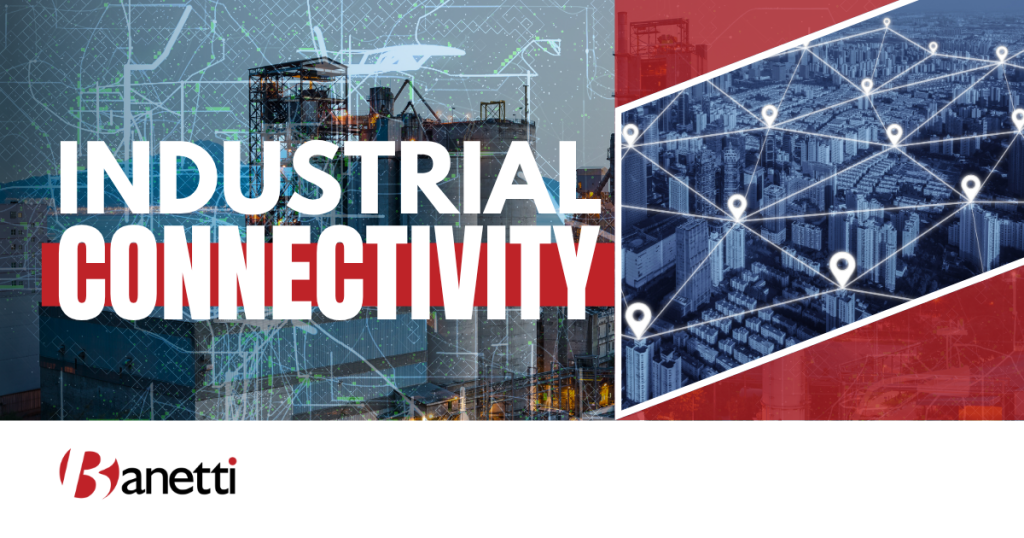5 Min Read
Table of contents

The manufacturing industry is in the midst of a digital transformation driven by industrial connectivity, the integration of machines, devices, and systems that enable real-time data transmission and automation across industrial environments. As organizations move toward Industry 4.0 and the Industrial Internet of Things (IIoT), connectivity solutions are becoming the foundation for smart manufacturing, predictive maintenance, and operational efficiency.
What Is Industrial Connectivity?

Industrial connectivity forms the backbone of modern manufacturing, linking every sensor, device, and application to create a seamless flow of operational intelligence.
Definition
Industrial connectivity is the ability to connect machines, sensors, controllers, and software systems to enable seamless communication and control in real time. It ensures that industrial devices and systems, from field devices to higher-level systems, exchange process data efficiently, securely, and without human intervention.
Why It Matters
Modern factories rely on both operational technology (OT) and information technology (IT) systems. Connectivity bridges this gap, allowing OT applications to share data with IT systems for integrated decision-making. This convergence enables scalable, data-rich, and interoperable industrial systems that drive productivity, reduce downtime, and improve efficiency.
Key Technologies Driving Industrial Connectivity

A robust connectivity ecosystem depends on several interlinked technologies that ensure secure, reliable, and intelligent communication across the industrial landscape.
Communication Protocols
Protocols such as Modbus, OPC UA, MQTT, and PROFINET serve as the backbone of industrial networks. They enable interoperability between new and legacy systems, ensuring that diverse machines and controllers can communicate across existing infrastructure. Protocol gateways and translators further support seamless communication across heterogeneous devices.
Edge Devices and Gateways
Edge computing plays a crucial role in data acquisition, aggregation, and real-time monitoring. Industrial routers and gateways handle remote configuration, data collection, and process automation, filtering information before sending it to the cloud. This reduces bandwidth use while maintaining low latency and secure boot capabilities.
Industrial Networking Infrastructure
Modern factory connectivity solutions rely on both wired Ethernet and wireless communications such as Wi-Fi, 5G, and private LTE. These industrial networks are designed to withstand harsh environments, ensuring data transmission continuity in hazardous locations like oil fields or mining sites.
Middleware and APIs
APIs and middleware connect OT systems with cloud computing and IIoT solutions, enabling analytics, visualization, and remote configuration. They help achieve a complete solution that integrates industrial operations with enterprise IT.
Cybersecurity in Connected Environments
As the number of connected devices grows, so does the risk of cyber threats. Modern industrial connectivity solutions now integrate user authentication, encryption, and anomaly detection to defend against intrusions. Frameworks like IEC 62443 ensure compliance and defense-in-depth security.
Industrial Connectivity Use Cases

Industrial connectivity enables real-world transformation across industries, improving uptime, productivity, and safety through connected intelligence.
Real-Time Monitoring and Diagnostics
Connected industrial environments use sensors and SCADA systems to enable real-time monitoring. Data from machines, transmitted through industrial networks, helps identify issues early, reducing costly downtime and improving operational efficiency.
Predictive and Condition-Based Maintenance
By continuously collecting and analyzing data from connected assets, companies can detect irregularities and predict failures. This predictive maintenance model reduces repair costs and extends equipment life, supporting smart applications that optimize scheduling and spare-part management.
Process Automation and Optimization
Connectivity enables adaptive manufacturing processes through feedback loops. Industrial automation powered by connected sensors and industrial internet technologies ensures smoother workflows, better traffic management on the shop floor, and faster response times.
Digital Twins
Digital twins, or virtual replicas of physical assets, use real-time data acquisition to simulate and optimize performance. These models enhance decision-making by integrating industrial operations with simulation environments.
Remote Operation and Support
Through cloud integration and edge computing, operators can manage industrial systems remotely, even in hazardous environments. This not only improves worker safety but also enables remote configuration and data collection from inaccessible sites.
Smart Asset Tracking and Inventory
IoT-based sensors allow data acquisition for tracking materials, tools, and components in manufacturing industry operations, minimizing loss and ensuring informed decisions in supply chain management.
Benefits of Industrial Connectivity

From the shop floor to the executive suite, the benefits of industrial connectivity extend across operations, sustainability, and profitability.
- Reduced Downtime:Predictive maintenance and continuous monitoring prevent costly production stoppages.
- Enhanced Efficiency:Real-time data insights streamline workflows and improve energy utilization.
- Unified Visibility:Centralized dashboards consolidate machine data for cross-departmental clarity.
- Scalability:Modular connectivity allows effortless integration with existing infrastructure.
- Sustainability:Optimized resource usage and smart automation reduce energy waste and emissions.
- Added Value:Converting raw data into actionable intelligence increases output quality and profitability.
Challenges to Overcome

Despite its advantages, achieving industrial connectivity comes with challenges:
- Legacy Systems:Many facilities rely on outdated technologies that are incompatible with modern IIoT solutions.
- Cybersecurity Threats:As the number of connected devices grows, cyber threats such as ransomware and data breaches increase.
- Scalability:Managing thousands of networked assets requires robust orchestration.
- Network Reliability:Ensuring seamless communication in harsh environments demands ruggedized hardware.
- Skill Gaps:Bridging the divide between IT systems and OT applications requires cross-disciplinary expertise.
Leading companies like Phoenix Contact and Siemens are addressing these challenges by creating interoperable, secure connectivity platforms designed to protect industrial networks today while supporting future scalability.
Best Practices for Industrial Connectivity

To build a resilient industrial connectivity service, manufacturers should:
- Map the Asset Landscape:Begin by identifying all devices, controllers, and industrial routers across the facility.
- Adopt Open Protocols:Use standardized, interoperable frameworks such as OPC UA and MQTT to unify industrial systems.
- Deploy Edge Computing:Process data locally to reduce latency and improve real-time monitoring.
- Integrate Cloud and OT Systems:Ensure cloud integration with secure boot and encryption to protect connected assets.
- Segment Networks:Divide networks for OT applications, production, and corporate IT to mitigate security threats.
- Continuous Monitoring:Track network performance, anomalies, and device health using predictive maintenance
- Cross-Functional Collaboration:Empower both OT and IT teams to manage configurations, reducing costly downtime.
Future Trends in Industrial Connectivity

Emerging technologies are redefining the future of connected industries: combining intelligence, autonomy, and speed at every level.
5G and Time-Sensitive Networking (TSN)
Next-generation wireless communications are revolutionizing data transmission in industrial environments, providing deterministic latency and reliability for real-time monitoring and process automation.
AI at the Edge
Artificial intelligence embedded in edge computing devices will soon enable smart applications capable of self-diagnosis, automatic fault recovery, and predictive analytics without cloud dependency.
Convergent Networks
Cloud computing and higher-level systems will merge with industrial networks, creating unified architectures for smart factory ecosystems that enable end-to-end visibility from field devices to enterprise dashboards.
Cybersecurity by Design
Future IIoT solutions will embed security at the hardware level, from user authentication to secure boot, ensuring connected assets remain resilient against cyber threats.
Human-Machine Collaboration
As industrial automation evolves, humans and connected devices will work in tandem, guided by data-driven decision-making to achieve new levels of operational efficiency.
Conclusion
Industrial connectivity is the engine behind the digital transformation of modern manufacturing, the force that enables smart factories, predictive analytics, and data-driven decision-making.
But the full potential of connected operations is realized only when connectivity meets intelligent asset management. That’s where Banetti comes in.
As a leading Enterprise Asset Management (EAM) consulting platform, Banetti helps organizations implement and optimize IBM Maximo®, ensuring that connected assets, sensors, and systems translate into measurable performance gains. With Banetti’s expertise, enterprises turn connected data into actionable insights: reducing downtime, improving productivity, and maximizing the value of IBM Maximo® within their industrial connectivity strategy.


